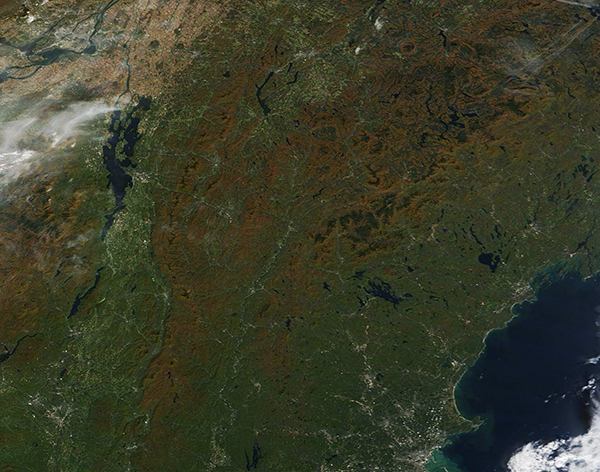Images
October 9, 2022 - Fall Colors in New England
Tweet
The forests of northern New England were nearing peak autumn color on October 6, 2022. That’s the same date that the Moderate Resolution Imaging Spectroradiometer (MODIS) on board NASA’s Terra satellite acquired a true-color image of a stunning flush of orange painting the high elevations between Montreal, Canada to Massachusetts, United States and from the Adirondacks to the White Mountains.
Each autumn, the changing colors of deciduous leaves paint North America with glorious shades of yellows, oranges, reds, and browns. The transition starts in the north and in high elevations as early as mid-September then sweeps downslope and southward until it is completed in mid-November. The changing of leaf color in temperate forests involves several causes and reactions, but the dominant factors are sunlight and heat.
As daylight begins to shorten in late summer and autumn, tree and plant leaves produce less chlorophyll, the green pigment that harvests sunlight for plants to convert water and carbon dioxide into sugars. The subsidence of chlorophyll allows other colorful chemical compounds contained in the leaves, such as carotenoids and flavonoids, to become visible.
The leaves of different deciduous tree species (the type that drop their leaves in the fall) contain a variable mix of pigments, and this means that they produce different colors in autumn. Oaks generally turn red, brown, or russet; hickories become golden bronze; aspen and yellow-poplar turn golden. Maples differ by species. Red maple turns brilliant scarlet; sugar maple, orange-red; and black maple, yellow. Leaves of some trees, such as elms, simply become brown. New England’s forests contain an abundance of deciduous trees and also are rich in coniferous trees, which do not drop their needles in the fall, but remain green year-round.
Image Facts
Satellite:
Terra
Date Acquired: 10/6/2022
Resolutions:
1km (252.7 KB), 500m (668 KB), 250m (1.5 MB)
Bands Used: 1,4,3
Image Credit:
MODIS Land Rapid Response Team, NASA GSFC
Tweet
The forests of northern New England were nearing peak autumn color on October 6, 2022. That’s the same date that the Moderate Resolution Imaging Spectroradiometer (MODIS) on board NASA’s Terra satellite acquired a true-color image of a stunning flush of orange painting the high elevations between Montreal, Canada to Massachusetts, United States and from the Adirondacks to the White Mountains.
Each autumn, the changing colors of deciduous leaves paint North America with glorious shades of yellows, oranges, reds, and browns. The transition starts in the north and in high elevations as early as mid-September then sweeps downslope and southward until it is completed in mid-November. The changing of leaf color in temperate forests involves several causes and reactions, but the dominant factors are sunlight and heat.
As daylight begins to shorten in late summer and autumn, tree and plant leaves produce less chlorophyll, the green pigment that harvests sunlight for plants to convert water and carbon dioxide into sugars. The subsidence of chlorophyll allows other colorful chemical compounds contained in the leaves, such as carotenoids and flavonoids, to become visible.
The leaves of different deciduous tree species (the type that drop their leaves in the fall) contain a variable mix of pigments, and this means that they produce different colors in autumn. Oaks generally turn red, brown, or russet; hickories become golden bronze; aspen and yellow-poplar turn golden. Maples differ by species. Red maple turns brilliant scarlet; sugar maple, orange-red; and black maple, yellow. Leaves of some trees, such as elms, simply become brown. New England’s forests contain an abundance of deciduous trees and also are rich in coniferous trees, which do not drop their needles in the fall, but remain green year-round.
Image Facts
Satellite:
Terra
Date Acquired: 10/6/2022
Resolutions:
1km (252.7 KB), 500m (668 KB), 250m (1.5 MB)
Bands Used: 1,4,3
Image Credit:
MODIS Land Rapid Response Team, NASA GSFC




